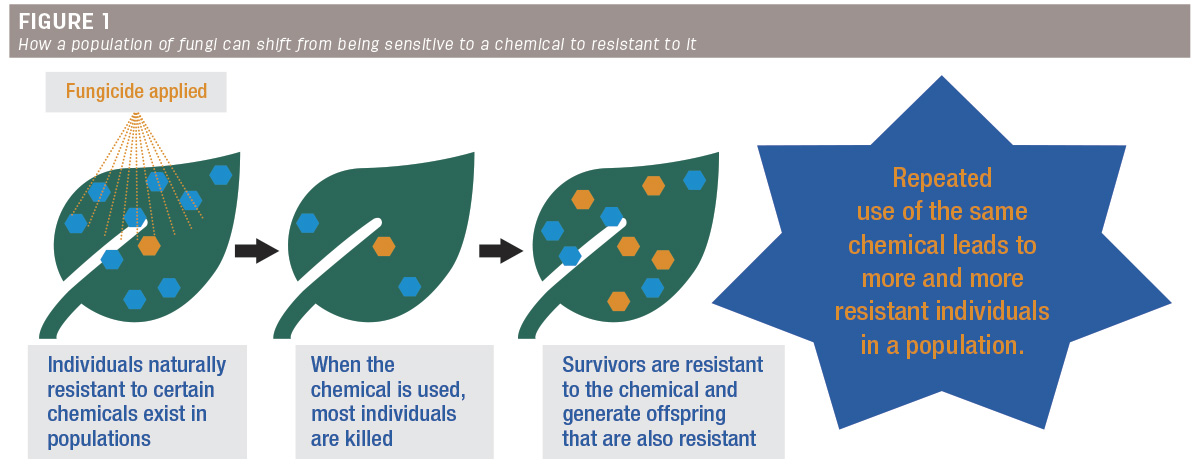The quote “Insanity is doing the same thing over and over again and expecting different results” is often attributed to Albert Einstein. This situation often occurs in my agricultural trials, where every year I test the effectiveness of fungicides against disease like fusarium dry rot or rhizoctonia canker in potato. We use fungicides to protect our crops from plant-pathogenic fungi. For many of the well-established fungicides with long track records, I can reasonably expect the same or similar results from one year to the next. Once in a while, though, our results may indicate a particular treatment works remarkably well in one year, and in the next year it might perform no better than the check. Though not entirely unexpected, I sometimes question my sanity when these situations arise. It usually means more of the same trials are needed – repeating the experiments over and over again until we are satisfied that a chemical does (or doesn’t) work as expected.
Why can data differ from one year to the next? In agricultural research involving crops, this discrepancy can be due to many factors that might differ from year to year or location to location, such as weather, soil, seed source, a fertility source, water and even human error. In my trials, where I’m testing fungicides, disease pressure can also play a role. In the context of testing fungicides, “insanity” can be defined as “testing only once” – a contrast to Einstein’s definition of insanity. We repeat, repeat and then repeat again – and our only expectation is to be as unbiased as possible. Regardless of the outcome (whether the results are the same or different), all the data garnered from the many trials that are conducted to evaluate a particular product contribute to the goal of determining whether a treatment works consistently and at a sufficient level. Sometimes, we repeat experiments over and over with an expectation that the results will be different – this is our skepticism as researchers at play. We need lots of data to convince us something is “real.”
Plant diseases are estimated to cause 8.1% to 21% yield losses in potatoes worldwide (source: “The global burden of pathogens and pests on major food crops,” a 2019 article in Nature – Ecology & Evolution). Most plant diseases are caused by fungi. As a result, we rely on fungicides (such as chemicals, microbes and plant extracts) to protect our food supply from potentially devastating yield losses or poor quality.
Only 12 different known modes of action of fungicides are available to us. These different modes of action are described by the Fungicide Resistance Action Committee (FRAC, a group dedicated to prolonging the effectiveness of fungicides and to developing approaches to manage fungicide resistance should it occur). Fungicide options are limited – not only because we have only 12 modes of action, but also because not all fungicides are created equal. Some fungicides work better against certain types of fungi than others, or in one situation over another. This means it is important to know what the pathogen is to best protect against it. In short, there are even fewer fungicides available to protect against a particular plant disease in a particular situation.
When we find a fungicide that is effective, it seems “sane” to want it to work the way we expect, time after time, right? However, this practice can often be risky. Why? Within a population of fungi, a very small number of individuals may be naturally resistant to a particular chemical. The practice of using that chemical over and over allows these resistant individuals to multiply. Repeated exposure to a fungicide can eventually lead to a shift in the population, from one that has mostly fungicide-sensitive individuals to one that has mostly fungicide-resistant individuals (Figure 1).

How can we reduce the risk of fungicide resistance and prolong the utility of our relatively limited types of fungicides? Information on resistance management for a particular product can be found on the fungicide label. Specific recommendations for the major fungicide modes of action are also available on the FRAC website. In any resistance management plan, the goal is to balance prolonging the utility of a fungicide with the needs of the grower. The following strategies are broadly recommended by FRAC:
- Avoid using the same product by itself over and over again.
Mix it with another product, with a different mode of action. Note that two different product names don’t necessarily mean the two products have different modes of action. Alternatively, rotate products with different modes of action.
- Limit the number of times a product is applied per season.
Similar to rotating products with different modes of action, this approach limits the exposure of fungi to the chemical. You can find on the fungicide label more information on how many times per season a chemical can be applied.
- Use the dose recommended by the manufacturer.
It may be tempting to apply a lower-than-recommended dose of a fungicide to reduce costs, especially if disease pressure is low. FRAC recommends resisting this urge, due to the possibility of enhancing the risk of the fungal population shifting toward resistance. The data are not necessarily clear on this stance, however, so this general recommendation may vary from one fungicide to another, and from one disease system to another.
- Use fungicides preventatively, rather than after the disease occurs.
It is tempting to harness the “kickback” activity attributed to some systemic fungicides, where the fungicide can “cure” or “eradicate” existing infections or prevent further spread of the pathogen. However, FRAC recommends avoiding this type of use, for two reasons: First, even when a systemic fungicide is applied with a mixture containing a different, protectant fungicide (which does not have “curative” properties), it is still in effect acting alone when applied to plants showing symptoms. This practice would pose the same risk as using only one product over and over again. Second, selection pressure in the pathogen population may be higher if a systemic fungicide is used after infection occurs. In other words, using systemic fungicides as protectants (before infection) in theory will prolong their utility.
- Develop an integrated disease management plan.
In this strategy, the goal is to implement multiple different strategies to reduce crop disease. These can include planting a crop that is resistant to the disease, crop rotation, sanitation, biological control agents and so on – anything that can help reduce the number of fungicide applications made over a given season. An integrated disease management plan will differ from one crop and disease to another. However, despite our best efforts, fungicides may still be the main option, especially for high-risk diseases like potato late blight. (Luckily for Idaho, our environment is seldom conducive for this highly destructive disease.) - Maintain diversity of fungicides.
This last strategy falls primarily on industry and regulatory entities: Manufacturers and innovators must press onward to find new chemistries and agents that can protect crops against disease. Regulatory entities must recognize the need for having many modes of action and different chemistries registered for use (as long as they meet safety standards, of course).
Practicing good stewardship of our limited fungicides is critical. Once a population of certain types of plant pathogens shifts to being resistant to a particular fungicide, our past experience tells us the population will not likely become sensitive again. The result is the practical loss of a fungicide. This situation occurred in Idaho in the 1990s, when populations of fungi that cause fusarium dry rot on potatoes in the Pacific Northwest shifted to being resistant to benzimidazole fungicides. Research from the University of Idaho shows that resistance persists today, and we continue to discourage use of benzimidazole fungicides to manage fusarium dry rot in potatoes in the region.
As a result, we must strive to practice good stewardship for each of our fungicides because losing any can hamper our ability to grow our crops with the yields and quality needed to feed our world.






